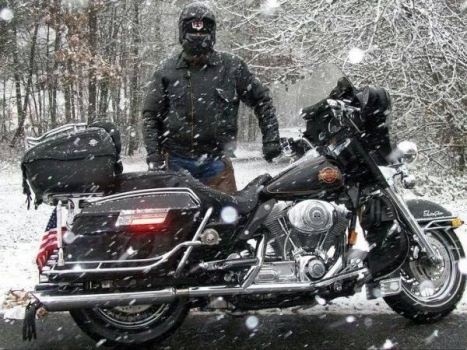
Ten Ways to Keep Riding in Winter
The arrival of cold weather doesn’t mean the departure of the desire to ride. Many motorcyclists in cooler climates refuse to retire their favorite motorcycle or scooter to the storage shed – and, thanks to today’s broad range of gear choices, it’s entirely possible to enjoy two wheels right into the winter months. Here are ten tips from the experts at Nationwide Insurance if you – and your bike – are on the road when temperatures dip.
– Get Layered. Layering will keep you insulated and warm. Start with a light base layer that’s breathable – microfiber is a good choice. Your base layer should trap warm air next to your skin and wick away sweat. Make sure your top layer is made of tough, windproof material, such as leather or nylon. Be sure layering clothing hasn’t restricted the movement you need to ride safely.
– Trap Body Heat. Keeping your hands and head warm is crucial – most body heat escapes there. To seal the gap between jacket and gloves, invest in gauntlet-style gloves. Consider wearing a silk or microfiber layer under your gloves as well. In addition, invest in a neck warmer or balaclava to prevent cold air from entering your helmet.
– Don’t Get Foggy. Visor fogging can cause hazardous visibility problems during cold weather. Wear a half-mask inside your helmet over a wind-proof balaclava. This combo allows your breath to escape without causing condensation inside the visor.
– Ride on Down Electric Avenue. Longer trips often require additional protection, such as electric vests and gloves. These accessories use your bike’s electrical system to provide heat. A vest, electric or regular, is essential to keeping the torso warm. A warm torso prevents frostbite by allowing the heart to focus on pumping blood to the hands and feet. Or, spring for the heated grip option available on many touring bikes.
– Watch the Voltage. Be sure your alternator can handle the addition of electric accessories, such as heated vests and gloves. Check your owner’s manual to find out how much wattage your alternator generates and how much of that wattage is used to run lights and other electrical components. Then, subtract the wattage the electric gear needs to be sure you have the power necessary, and some to spare, when running the accessories.
– Get Streamlined. Direct chilly air away from your body by adding a functional, not just cosmetic, fairing. Your height and torso length will dictate the proper height of the fairing – if a stock product doesn’t dispel the airflow correctly, have a fairing custom cut.
– Don’t Get Fooled. Hypothermia is insidious. If you ignore early symptoms, like uncontrolled shivering and numb fingers or toes, slow reaction times or fuzzy thinking, you could get into trouble, fast. Wind chill adds to the danger, so make sure you stop frequently, enjoy a hot beverage and allow your body to warm up.
– Practice Tire Smarts. If you fit sticky race-type tires in the summer, be sure to switch back to ordinary street tires during colder months. They develop grip at lower temperatures and reach effective operating temperatures much more quickly.
– Put Your Oil on a Diet. Using thinner oil during the cold months will improve your bike’s performance, especially during start-up, but check your owner’s manual for recommendations. Some manufacturers recommend only one weight of oil, no matter what the temperature.